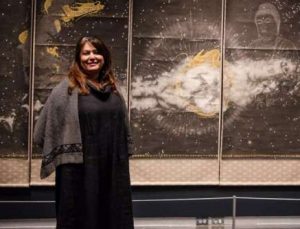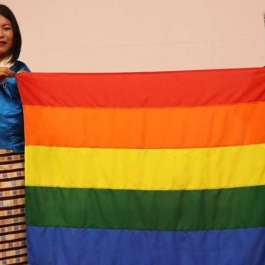
The Koyasan temple complex, a 12-century Buddhist site in Japan’s Wakayama Prefecture, is hosting a two-month art festival until 15 December. The festival commemorates the 1,250th anniversary of the birth of Kukai (also known as Kobo Daishi), the iconic Buddhist priest who founded the temple complex and Shingon, the Japanese branch of Vajrayana Buddhism.
The Koyasan temple complex is perched on a picturesque mountaintop and is seen as a testament to the spiritual and architectural achievements of the Shingon school of Japanese Buddhism. As the venue for this celebration of art and Buddhism, the complex is intended to stand as a tribute to the memory of Kukai.

The art festival, known as Koyasan Art Days (KAD), draws from both Buddhist and Buddhist-inspired art, bridging the divide between new creations from emerging artists and historical national treasures dating back centuries. It will take place in the vicinity of the temple Kongobu-ji and will include a public art exhibition and events in the garden near the entrances of the Reihokan Museum and Daishi Kyokai, the administrative headquarters of Shingon Buddhism. Among the works on display are several inspired by artifacts from Koyasan, masterfully crafted by notable Japanese artists such as Tamae Hirokawa, Yuko Bito, and Hideki Yoshimoto.
Unesco World Heritage Site Koyasan in Wakayama is hosting a two month-long art festivalhttps://t.co/0LojjFPVOH
— Embassy of Japan in Canada (@JapaninCanada) October 21, 2023
Art and music have long danced in harmony, and KAD’s Art Days Concerts, hosted at venues such as Kongobu-ji, offer a melodious experience for attendees. The Tokyo Philharmonic Orchestra string quintet will perform classical compositions that transcend time, while Wakayama-based ensemble Key Trad will enchant audiences with traditional Japanese music.
As the sun sets on these remarkable exhibits, KAD extends an invitation to explore these hallowed structures under a celestial canopy. The Special Night Openings, which transpire at Kongobu-ji from 16–20 and 23–27 October, followed by Reihokan Museum from 30 October–3 November, promise a transcendent viewing experience. During these serene evenings, captivating events unfold, including special screenings and artist-led talks. The Koyasan Tourism Information Center has also contributed to the wealth of knowledge by showcasing informative exhibition panels.
The KAD website notes:
By creating a crossing where Koyasan’s Buddhist art meets contemporary productions, Koyasan Art Days invites participants to savor the artistic creations of this holy mountain from a brand new perspective. During this period, visitors can enjoy contemporary art exhibitions and concerts at the main temple Kongobuji and other selected sites within Koyasan, night visits of Kongobuji and Reihokan Museum, garden light-ups, and art exhibitions at affiliated temples. We welcome visitors from all over the world to discover the infinite enchantments of Koyasan by joining us at this unique crossroad of the past and now.
(Koyasan Art Days)
Kukai, also known as Kobo Daishi, lived during Japan’s Heian period (794–1185) and is celebrated for his multifaceted contributions. He was a prolific writer, calligrapher, and artist, his creations reflecting deep insights gained through his practice of esoteric Buddhism. Kukai founded the Shingon school, emphasizing the importance of direct experience and the unity of the physical and spiritual worlds. His teachings continue to inspire Buddhists, particularly those drawn to Shingon’s intricate rituals and meditative practices.
Buddhism has seen precipitous decline in Japan in recent decades. According to a 2015 report by The Guardian, more than one in three temples are expected to close by 2040. In large part, these are small rural temples that will simply have no more practitioners living near them as young people leave for the cities and never return.
“The popular image of Buddhist priests as wealthy might still be true in big cities like Tokyo and Osaka, but it’s not the case elsewhere,” said Ukai, author of Vanishing Temples: the Loss of Rural Areas and Religion. (The Guardian)
See more
Unesco World Heritage Site Koyasan in Wakayama is hosting a two month-long art festival (TimeOut)
Koyasan Art Days
Zen no more: Japan shuns its Buddhist traditions as temples close (The Guardian)
Related news reports from BDG
Historic Japanese Temple Allegedly Vandalized by Canadian Teen
Weekly Toyo Keizai: Buddhism Facing a “Life or Death Struggle” in Japan
Japanese Buddhist Temple Offers Immersive CGI Imagining of the Pure Land
Japanese Buddhist Priest Transforms Traditional Goshuin Stamps into Works of Art
Related features from BDG
Rebirth and Revolution – Engaged Buddhism in Japan: A Conversation with Jonathan Watts
Zen in the Mettaverse: How a 400-Year-Old Buddhist Temple is Evolving in Response to Modern Japanese Suffering
Religion as Practice: The Shikoku Pilgrimage in Japan
Animals in Priestly Robes in Japanese Art
Art in Japanese Buddhism












